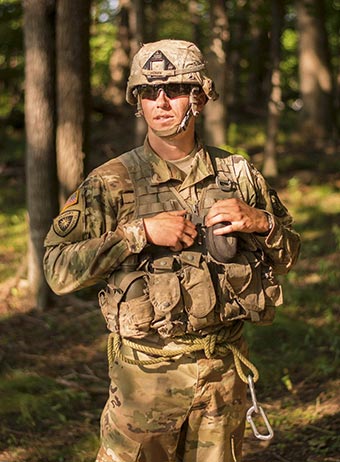SJU senior is ranked No. 5 nationally among ROTC cadets
December 13, 2018
By Mike Killeen

Cadet Marvin Heimer, a Saint John’s University senior, was recently named the No. 5 ROTC cadet in the country. He is shown during the Ranger Challenge at Saint John’s Abbey Arboretum.
Each summer, some 5,000 ROTC cadets who will graduate the following May attend Summer Cadet Training at Fort Knox, Kentucky.
“I think of it as kind of like the NFL Combine,” said Saint John’s University senior Marvin Heimer, a member of the Fighting Saints ROTC Battalion that includes students from SJU, the College of Saint Benedict and St. Cloud State University.
Similar to the NFL Combine, the cadets go through a series of physical and leadership tests. And, much like how the results at the NFL Combine determine who gets selected in the NFL Draft, Summer Cadet Training is one tool used to help determine a ranking of the top 10 cadets nationally.
Heimer must have aced that test. He was recently named the No. 5 ROTC cadet nationally.
“I was kind of surprised,” said Heimer, a senior mathematics major who is from a farm just outside Elkton, Minnesota – a town of about 100 people east of Austin near the Minnesota-Iowa border.
“I knew for a few weeks I was going to be in the top 10, because Maj. (Steve) Beard (professor of military science and head of the Fighting Saints ROTC battalion) told me that. We just didn’t know what number.”
Heimer is the fourth cadet from the 136-member battalion to be ranked nationally.
In 2017, cadets and CSB seniors Becca Dykhoff and Mary Esker ranked Nos. 1 and 3 among ROTC nursing cadets. In 2015, Paul Knaak was ranked the No. 4 cadet in the country. Beard mentioned that an additional 11 cadets from the battalion rank among the top 20 percent nationally this year.
Guess who mentored Heimer as a first-year ROTC cadet? Knaak.
“He showed me what right and wrong looked like as an ROTC cadet,” Heimer said of Knaak. “He gave me helpful advice on what to do in ROTC. Mentoring is something the Fighting Saints is pretty good about.
“The Fighting Saints kind of have a recipe for success, but it’s an unsung recipe that’s rooted in the family dynamics encouraged by the cadre, as well as the core values that all the cadets unknowingly uphold,” Heimer continued. “The core values that I think the battalion has but doesn’t necessarily define are humble, hungry and smart, and those three cadets (Dykhoff, Esker and Knaak) lived out those values when they were here, and they still do.”
Coincidentally, Beard used those same words to describe Heimer.
“He’s gifted as he is humble. He’s just one of those guys who has a positive personality and is totally reliable,” Beard said. “He’s one of those people who are sneaky good. He does well in the classroom, he does well on the physical fitness field and before you know it, he’s a fantastic young man.
“He was raised on a farm here in Minnesota, and I think he really carried that work ethic to the way he was raised. He applied it here at Saint John’s and to Army ROTC. He’s one of those people who is a tireless worker, and always has a positive attitude. He’s always looking to the next challenge.”
Heimer’s next challenge may be at the holiday dinner table. His wife, Kelly (Dills) Heimer, is a senior cadet in the battalion. His brother, Mason, is a first-year student in the battalion.
“She is very competitive, and initially, she was kind of upset that I beat her in the rankings,” Marvin Heimer said. “But she quickly realized how cool it is, and was very supportive.”
Beard said there is an ongoing discussion about who the top Heimer is in the battalion, noting that Kelly Heimer “probably scored just outside the top 10. We know for a fact that she’s in the top 10 percent nationwide.”
But the married couple of just over two months will be briefly splitting up after graduation. Marvin Heimer will be going to Fort Sill, Oklahoma, to receive basic officer leadership training in field artillery. Kelly Heimer will be attending Fort Jackson, South Carolina, to receive training as a finance officer.
“I have a little connection with the family,” Heimer said. “I wanted to do combat arms, and so it was just a choice of which one was best for me. And, the field artillery was best for me.”
“Field artillery is a branch that is very math intensive, which is interesting because Marvin is a math major,” Beard said. “You might think it’s simple, but it’s not shooting shotguns. You have to take into account elevation, humidity and changes in the weather, and you have to calculate the firing solutions.
“It’s very math intensive, so I think Marvin will have a leg up when he gets there,” Beard added.
